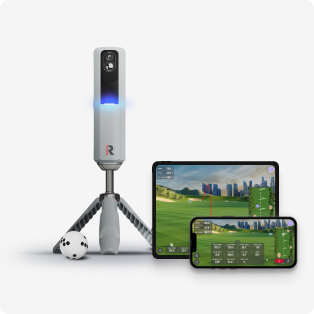Precision is critical when it comes to golf launch monitors. Performance influences a golfer’s ability to hone their game and play virtual courses and golf challenges. Whether playing one of the 30k courses available to hitting one of 72 distance targets, golfers want a realistic ball flight and performance. This study assesses its ball flight estimation algorithm against two established counterparts, Foresight’s GC3 and Trackman’s Golf Launch Monitor TM4.
Key focus lies in differentiating between impact moment parameter measurement and subsequent algorithmic ball trajectory estimation. These distinctions govern the calculation of metrics like carry distance, lateral displacement (side carry), maximum height that the ball reaches (apex), and shot curvature (shot shape), all influential in golf strategy.
The following shows the analysis for the evaluation metrics through a comparison with the Foresight’s GC3 and Trackman’s Golf Launch Monitor TM4.
Method
To assess the the Rapsodo MLM2PRO’s ball flight algorithm, we employed a systematic evaluation method that examined consistency and precision. To compare ball flight algorithm performance without the influence of shot parameter measurement errors, we utilized shot parameters obtained from the control device (either GC3 or TM4). These parameters include metrics such as launch angle, launch direction, ball speed, spin axis and spin rate.
Using these shared parameters, we employed the test device's (MLM2PRO) ball trajectory estimation algorithm to compute the corresponding trajectory statistics. We will further describe these statistics in evaluation metrics section.

Evaluation setup for MLM2PRO’s ball flight estimation algorithm
The objective was to conduct a direct comparison of the trajectory statistics with those calculated by the control device's algorithm. This analysis enabled us to effectively evaluate the performance of the MLM2PRO's ball flight estimation algorithm. Importantly, this comparison was conducted under uniform conditions, as the input parameters for both the test and control devices are identical, ensuring a fair and scientifically sound evaluation.
In the subsequent sections, we further share the specifics of our methodology, the data collection process, the statistical measures employed, and the analytical techniques applied to draw meaningful comparisons. This methodology ensures that our assessment of the MLM2PRO's ball flight algorithm is both objective and reliable, providing golfers with valuable insights into its real-world performance.
Evaluation Metrics
In our evaluation of MLM2PRO's ball flight algorithm, we used a set of evaluation metrics designed to provide a comprehensive assessment of its performance. The primary metric of our analysis was carry distance. We scrutinized the absolute carry distance error, quantifying the disparity between the control and test devices' flight models. We utilized the absolute carry distance percentage, calculated as the absolute error divided by the carry distance and then multiplied by 100, offering a normalized perspective on the accuracy of the test device's estimations. Additionally, we considered the maximum absolute carry distance error, pinpointing the most significant discrepancies between the two algorithms. These metrics provide a robust framework for evaluating the test device's ball flight algorithm, ensuring a meticulous and objective assessment of its real-world accuracy and precision.
Dataset
In the process of conducting our evaluation of MLM2PRO's ball flight algorithm, we gathered data from two distinct control devices (GC3 and TM4), each equipped with its own specialized technology for capturing shot parameters. GC3, which formed the basis for evaluating a significant portion of our dataset, relies on a multi-camera system. The second control device, TM4 operates on different technology, utilizing 3D Doppler radar. We collected thousands of shots using both devices.
Comparison Results
Following is the overall results for GC3 vs MLMPRO and TM4 vs MLM2PRO in TABLE I below.
|
Control Device |
Mean Absolute Carry Difference (yd) |
Mean Absolute Carry Difference Percentage (%) |
|
GC3 |
2.24 |
1.81 |
|
TM4 |
0.66 |
0.51 |
The focus on our analysis was on the spin rate versus ball speed. These plots offer crucial insights into the performance of the algorithm under various shot scenarios.


These shots are marked by high initial ball speeds and a deliberate attempt to minimize spin for maximum distance. However, the precise balance between speed and spin in these shots is challenging to achieve. Consequently, even small deviations in the algorithm's ability to accurately model these shots can result in significant variations in carry distance.
Discussion
In our analysis of the comparative performance of the MLM2PRO's ball flight algorithm, several noteworthy findings have emerged from our evaluation metrics. Notably, our evaluation has shed light on the MLM2PRO's ability to estimate real-world golf shot trajectories, specifically in comparison to two distinct control devices.
Upon examination of these findings, we can conclude that the MLM2PRO’s ball flight algorithm exhibits a higher degree of algorithmic congruence. Our comprehensive evaluation indicates that the MLM2PRO's ball flight algorithm aligns both optical and 3D Doppler radar technology for shot parameter measurement. This observation provides valuable insights into the MLM2PRO's real-world accuracy and highlights its algorithmic strengths.













